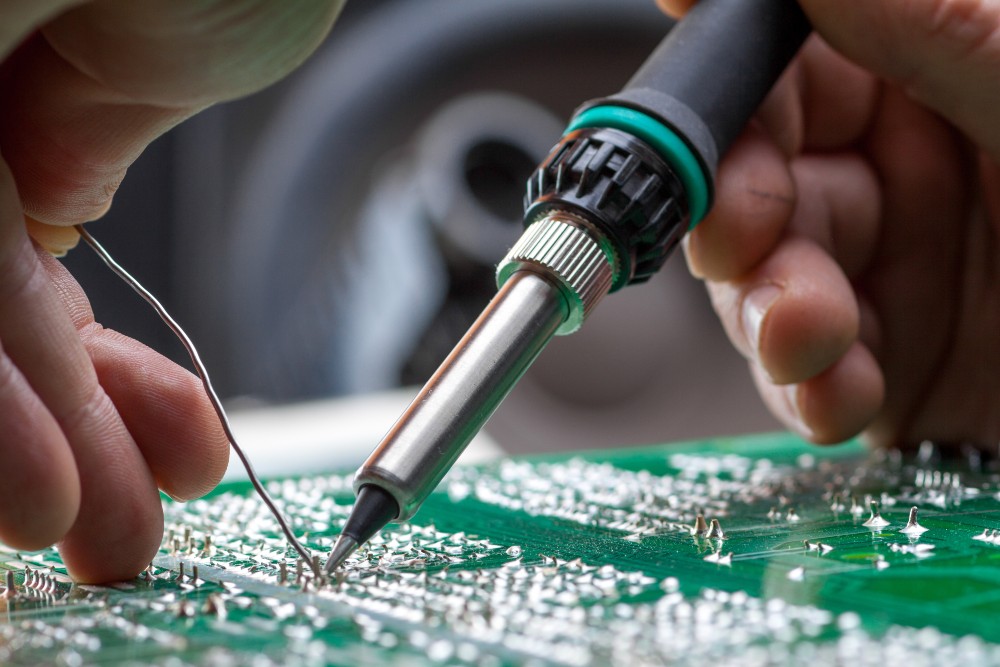The soldering board is the process of soldering several pieces of steel with different materials, thicknesses, and coatings to form a complete plate, to meet the requirements of different parts of the component for different material properties.
Take the door inner panel as an example: to ensure functional requirements, the main body of the door inner panel must have a certain degree of flexibility, while the front and rear parts of the door panel need to have a certain degree of strength. If traditional stamping forming methods are used, additional strengthening plates need to be designed. However, using soldering technology, three steel plates with different thicknesses can be welded together into a whole plate to form stamping.

A soldering board is the process of soldering components onto a printed circuit board (PCB). During the PCB welding process, the welding points are heated to combine with the copper foil on the circuit board to achieve electrical connection and mechanical fixation. Soldering boards are one of the essential processes in the manufacturing of electronic equipment and products.
Soldering boards are usually divided into two types: surface mount (SMT) and plug-in welding. SMT soldering is a soldering technique that welds surface mount components onto the surface of a PCB. Plug-in soldering involves inserting plug-in components into PCB holes and heating the solder joints to achieve connection. Both welding techniques have their advantages and disadvantages, and they need to be selected based on actual needs.
During the process of the soldering board, special equipment and tools need to be used, such as a soldering furnace, hot air gun, soldering table, soldering wire, etc. In addition, when conducting SMT soldering, equipment such as SMT mounting machines and reflux furnaces are also required. These equipments and tools can help welding workers achieve efficient and high-quality welding work.
The quality of soldering boards has a crucial impact on the performance and reliability of electronic equipment. Poor soldering can lead to problems such as solder joint cracking, short circuit, and solder leakage, thereby affecting the service life and stability of the equipment. Therefore, when conducting PCB soldering, it is necessary to pay attention to some details, such as welding temperature, solder amount, soldering time, welding method, and so on. At the same time, it is also necessary to inspect and test the soldering points to ensure that the soldering quality meets the requirements.
Type of soldering board
Reflow soldering
This is the most commonly used technique, where a specific amount of sturdy solder is placed at a specific location on an object and directly fed into a so-called reflux furnace. Subsequently, the heat from the reflux causes the solder to liquefy, and once it leaves the oven, it solidifies - which helps to form solder joints.
Wave soldering
This is a selective welding in which specific parts of the board are welded, as the component must be fixed to these parts It is achieved by developing a wave of liquid solder. This is a very general process because the wave soldering machine is very easy to connect, such as by dragging the board and components through the wave soldering machine.
Manual soldering
Manual soldering is a common welding method, which involves manually heating and melting the solder wire or electrode before applying it to the pins or pads of the circuit board, making the pins or pads tightly connected to the components on the circuit board. Manual welding requires operators to have certain welding experience, as parameters such as temperature, pressure, and time need to be controlled during soldering.
Laser soldering
Almost like reflow soldering, a solid solder is placed on the plate and heated until it begins to flow and complete the solder joint. But it is done with the help of lasers in certain positions, and it is the most flexible and ultimate in terms of accuracy. Of course, installation components and through-holes can also be laser welded, and this type of soldering board often reduces risks.
Application advantages of laser soldering technology in soldering board
1. The laser soldering machine has a high degree of automation and a simple soldering process. Convenient operation, due to the small focusing spot, high soldering seam positioning accuracy, convenient beam transmission and operation, there is no need to frequently replace the welding gun and nozzle, greatly reducing auxiliary time for shutdown.
2. Noncontact operation mode, meeting the requirements of cleanliness and environmental protection. The energy comes from the laser and there is no physical contact with the workpiece, so no force is applied to the workpiece.
3. High machining accuracy can reduce reprocessing costs. Laser soldering can reduce the heat input to the minimum required, the metallographic variation range of the Heat-affected zone is small, and the deformation caused by heat conduction is also the minimum.
4. The beam quality of nanosecond pulsed fiber lasers is high. The core diameter of optical fibers is in the order of several micrometers, which can greatly improve the optical quality of lasers and meet the high-quality requirements of industrial processing.
5. Small size. Fiber optics have good flexibility, allowing lasers to be designed relatively small, compact, and easy to integrate. They can also work in relatively harsh environments such as high impact, strong vibration, high temperature, and heavy dust.
A soldering board is one of the important processes for manufacturing electronic equipment. When conducting PCB soldering, it is necessary to select appropriate soldering techniques and equipment, pay attention to soldering details, and inspect and test the soldering points to ensure that the soldering quality meets the requirements.